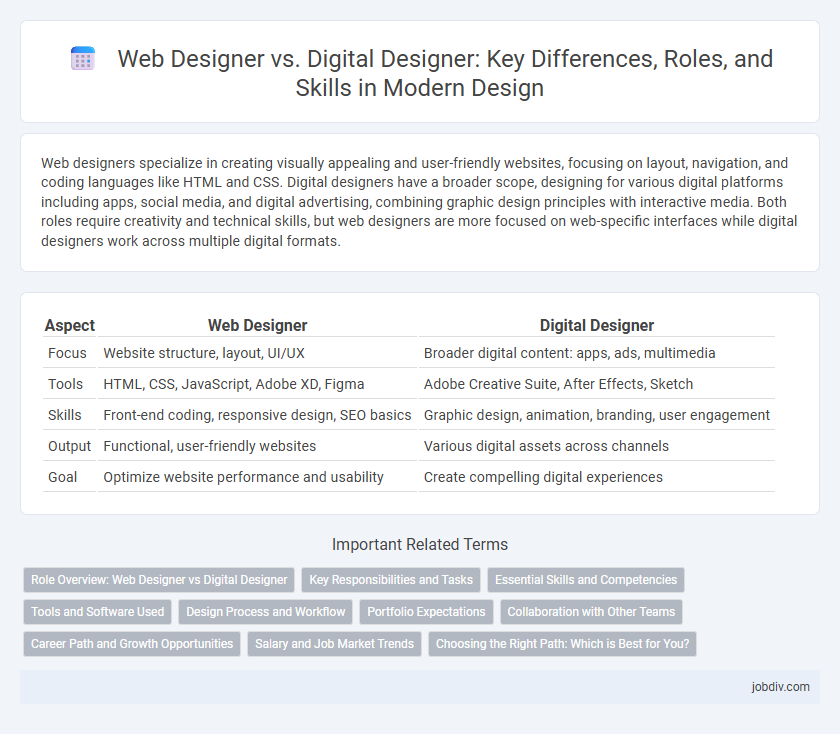Web designers specialize in creating visually appealing and user-friendly websites, focusing on layout, navigation, and coding languages like HTML and CSS. Digital designers have a broader scope, designing for various digital platforms including apps, social media, and digital advertising, combining graphic design principles with interactive media. Both roles require creativity and technical skills, but web designers are more focused on web-specific interfaces while digital designers work across multiple digital formats.
Table of Comparison
| Aspect | Web Designer | Digital Designer |
|---|---|---|
| Focus | Website structure, layout, UI/UX | Broader digital content: apps, ads, multimedia |
| Tools | HTML, CSS, JavaScript, Adobe XD, Figma | Adobe Creative Suite, After Effects, Sketch |
| Skills | Front-end coding, responsive design, SEO basics | Graphic design, animation, branding, user engagement |
| Output | Functional, user-friendly websites | Various digital assets across channels |
| Goal | Optimize website performance and usability | Create compelling digital experiences |
Role Overview: Web Designer vs Digital Designer
Web Designers specialize in creating visually appealing and user-friendly websites by focusing on layout, typography, and responsive design to enhance the user experience across various devices. Digital Designers encompass a broader scope, including not only web interfaces but also digital campaigns, mobile apps, and multimedia content, integrating graphic design with user interaction principles. Both roles require proficiency in design software such as Adobe XD and Figma, but Digital Designers often collaborate more extensively with marketing and development teams to ensure cohesive digital branding.
Key Responsibilities and Tasks
Web Designers specialize in creating visually appealing and user-friendly websites by focusing on layout, color schemes, typography, and responsive design to enhance user experience across devices. Digital Designers handle a broader spectrum, including visual content for websites, social media, email campaigns, and digital advertising, combining graphic design, animation, and interactive media skills. Both roles require proficiency in design software like Adobe Creative Suite and collaboration with developers or marketing teams to align design objectives with business goals.
Essential Skills and Competencies
Web designers excel in HTML, CSS, and responsive design, mastering user interface (UI) and user experience (UX) principles to create functional, accessible websites. Digital designers focus on a broader skill set that includes video editing, animation, and graphic design software like Adobe Creative Suite, emphasizing visual storytelling and brand consistency across digital platforms. Both require proficiency in prototyping tools such as Figma or Sketch, but web designers prioritize code-based frameworks while digital designers lean toward creative visual content development.
Tools and Software Used
Web designers primarily use tools such as Adobe XD, Figma, and Sketch for creating user interfaces and ensuring responsive web layouts, while digital designers often work with a broader range of software including Adobe Photoshop, Illustrator, and After Effects to create multimedia graphics, animations, and branding assets. Web designers focus on front-end coding environments like HTML, CSS, and JavaScript alongside design tools to optimize website functionality and user experience. Digital designers integrate cross-platform software to deliver diverse visual content across web, mobile, and social media channels.
Design Process and Workflow
Web Designers specialize in creating user-friendly interfaces through wireframing, prototyping, and coding, often collaborating closely with developers to optimize site functionality and responsiveness. Digital Designers encompass a broader scope, integrating graphic design, animation, UX/UI principles, and multimedia content within a workflow that includes research, concept development, and cross-platform adaptability. Both roles prioritize iterative testing and feedback loops, but Web Designers focus more on technical implementation while Digital Designers emphasize visual storytelling and brand consistency.
Portfolio Expectations
A Web Designer's portfolio emphasizes responsive layouts, UI/UX principles, and proficiency with HTML, CSS, and JavaScript, showcasing interactive websites and accessibility standards. A Digital Designer's portfolio highlights a broader range of digital assets, including motion graphics, social media content, and brand identity, demonstrating expertise in tools like Adobe Creative Suite, After Effects, and prototyping software. Employers expect Web Designers to deliver functional and user-centric digital experiences, while Digital Designers must exhibit versatility in creating visually compelling multimedia across multiple digital platforms.
Collaboration with Other Teams
Web designers collaborate closely with developers to implement user-friendly interfaces and ensure seamless functionality across platforms. Digital designers work alongside marketing, UX, and product teams to create cohesive visual assets that align with brand strategies and user experience goals. Both roles require clear communication and adaptability to integrate feedback and optimize final digital products effectively.
Career Path and Growth Opportunities
Web designers specialize in creating visually engaging and user-friendly websites, mastering HTML, CSS, and UX/UI principles, which leads to roles like front-end developer or UX specialist. Digital designers have a broader skill set encompassing multimedia content, branding, and interactive design across platforms, opening career paths in motion graphics, digital marketing, and product design. Growth opportunities for web designers often focus on technical expertise and specialization, while digital designers benefit from versatility and adaptability in diverse digital environments.
Salary and Job Market Trends
Web designers typically command salaries ranging from $50,000 to $80,000 annually, driven by steady demand in website development and user interface projects. Digital designers, encompassing broader roles including multimedia and UX/UI design, often see higher average salaries between $60,000 and $90,000 due to growing market trends favoring versatile digital content creators. Job market trends indicate increasing growth for digital designers as businesses prioritize multi-platform experiences and integrated visual strategies.
Choosing the Right Path: Which is Best for You?
Web designers specialize in creating responsive, user-friendly websites optimized for performance and SEO, focusing on coding languages like HTML, CSS, and JavaScript. Digital designers work across multiple digital platforms, including social media graphics, app interfaces, and multimedia content, emphasizing visual storytelling and brand consistency. Choosing the right path depends on your skills and interests: opt for web design if you enjoy technical, front-end development, or digital design if you prefer versatile, creative projects across diverse mediums.
Web Designer vs Digital Designer Infographic

 jobdiv.com
jobdiv.com